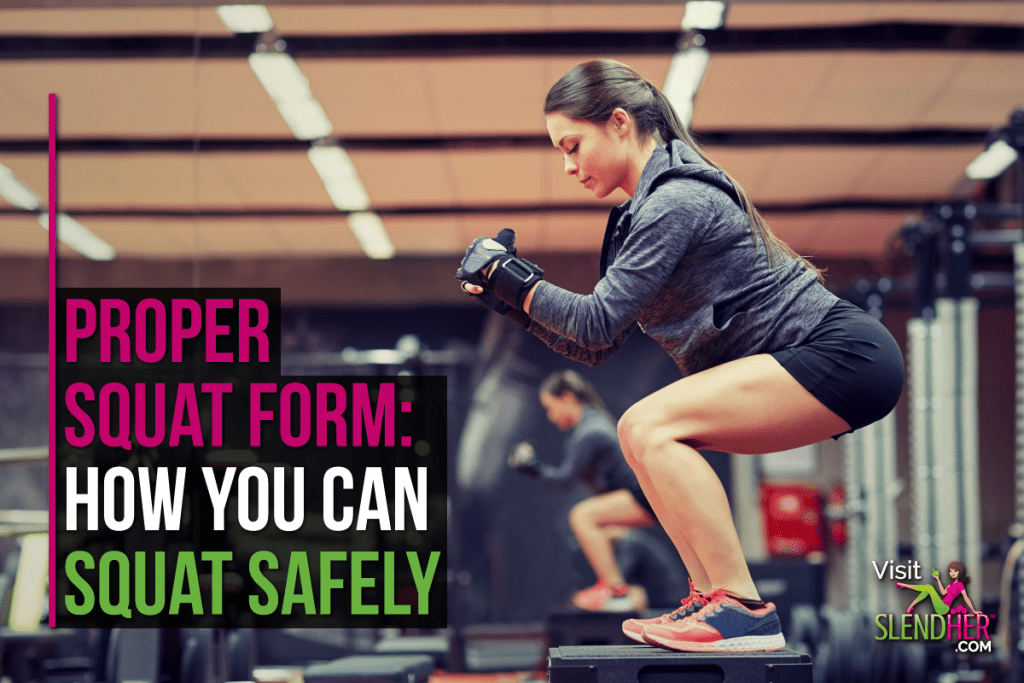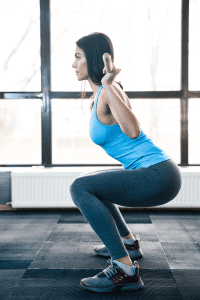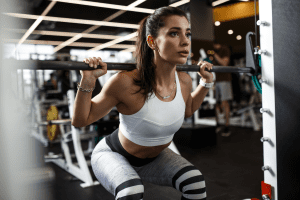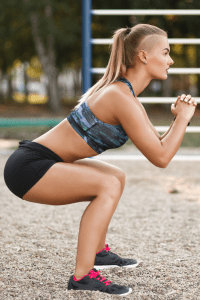
The squat is a superior movement for the whole body, which is why it’s important to have proper squat form to ensure you protect your whole body. It is a perfect exercise for targeting all the major muscles of the body and is a fantastic exercise whether working out at home, a gym, in the garden, on holiday, and with or without equipment. The squat is the ultimate exercise to have in your fitness tool kit.
Squats work your full body. As you know they work the legs, the whole legs all the way up to the glutes. Your abs and lower back muscles stabilise the trunk of the body whilst your legs move. The upper back, shoulders and arms balance the bar for bar squats, and even in bodyweight squats, these muscles are targeted to help when balancing the body. With most compound movements (big movements) most, if not all, muscles are used as they are linked and need to support each other to ensure the body moves efficiently and protects itself in the movement.
As the squat uses a lot of muscles, it is crucial to learn proper squat form so that you can get maximum results from the exercise and avoid injury.
What is the Proper Form for a Squat?

Proper Squat Form
Let’s start with the basics for proper squat form.
- Stand with feet a little wider that hip width, toes facing to the front. You might find it comfortable to have toes pointing out at a slight angle.
- Push your bodyweight through your legs into the centre and heels of your feet. You should be able to wiggle your toes when squatting if your bodyweight is centred correctly without falling when lifting the toes.
- Look forward, keep your chest up.
- Embrace your stomach muscles, keep the abdominals tight. Avoid arching the back.
- Drive your hips back. Bending at the knees and pressing your slightly open.
- Sit into a squat position, keeping the heels pushed into the ground. Keeping the chest up and shoulders back.
- Do not let the buttocks touch the ground. Aim to reach parallel, where the knees are bent at a 90 degree angle.
- Press into your heels and straighten legs to return to a standing position.
Bodyweight Squats
When performing a bodyweight squat, it is the same as above. Ensure you get the bodyweight squat form correct before using any type of weight in the squat. Do not add kettlebells, dumbbells or barbells until you are confident in a bodyweight squat. This ensures your body is fully able to do the full range of movement without injury and is flexible enough to perform the movement. Never add weight when first learning how to do a proper squat.
Bar Squats

When performing a bar squat, the concept of the movement is the same as the basics stated above, however, you do need to make a few adjustments when holding the bar.
When using a squat rack, it is important to set up properly with the squat rack before squatting with the barbell on your back.
- Facing the bar, step under it, and put your hands around it on either side of you.
- Do not go too wide with your grip, ensure the hands have a stable safe grip. The width of the grip will depend on your flexibility, and whether you are doing a high bar squat or low bar squat.
- Pull the bar into your body. Look forward.
- With the weight on your shoulders, step back away from the supports of the squat rack.
- Your feet should be slightly wider that hip width.
- Your toes should be pointing slightly outwards,
- Engage your stomach muscles, squeeze your glutes, pull the bar into the body, inhale deeply into your stomach.
- Move the butt back and drive hips back.
- Squat down slowly whilst pushing the feet into the ground.
- Squat to reach parallel.
- Explode back up to the starting position with power.
- Once you have completed the set, walk back to the supports of the squat rack and return the weight safely onto the supports.
Where Should You Hold the Bar When Squatting?
You can do a high bar or low bar back squat. This depends on your flexibility, the weight being lifted and generally what feels best for you for holding a heavy weight. Practice with variations with an empty bar to see what suits your style of barbell back squats.
How Do Women Squat Correctly?
 When performing a squat, it is the same movement for women and men. You do not need to change the technique of the squat as a woman. It is important that you learn how to perform a bodyweight squat first before adding weights so that your body can adapt to the extra weight.
When performing a squat, it is the same movement for women and men. You do not need to change the technique of the squat as a woman. It is important that you learn how to perform a bodyweight squat first before adding weights so that your body can adapt to the extra weight.
If you are pregnant or recently had a baby, it is very important to understand your body. If you lifted weights and did workouts with squats before getting pregnant, then you might be ok to continue squats with and without weights, or you might not. Pay attention to your body the further into your pregnancy you get and see how your muscles and joints feel. Do not continue if there is pain or it simply does not feel right to perform. Adapt the weights and movement during the pregnancy if you can continue doing squats.
If you have never performed squats before, bodyweight or with weights, when pregnant, do not start doing squats. Wait until you have healed from birth and seek professional advice.
Once you have had your baby, and depending on your fitness experience, seek professional advice on when it is suitable to start fitness workouts that include squats. Perform squats with common sense, and focus on engaging your core muscles, do not use weights at first, and get used to the whole movement again post-pregnancy. Your body will feel different, you will have lost strength, and many muscles may need to recover from the pregnancy and birth. Give your body time to heal after pregnancy and birth. Squats can wait!
Where Should You Feel Squats?
You should feel squats everywhere, and not just in the legs. Squats are a full body movement which require large and small muscles to work. Whether doing a bodyweight or barbell squat, all squats are working the body. When performing the squat, you should initially feel it in the abdominals, glutes and legs. If you are doing a barbell squat, you should feel it in the arms, upper back and shoulders. And of course – the brain! The contention and focus of a squat is working the muscles in your mind.
Do you enjoy squats? What are your favourite type of squats to do? We would love to hear from you!

Leave a Reply